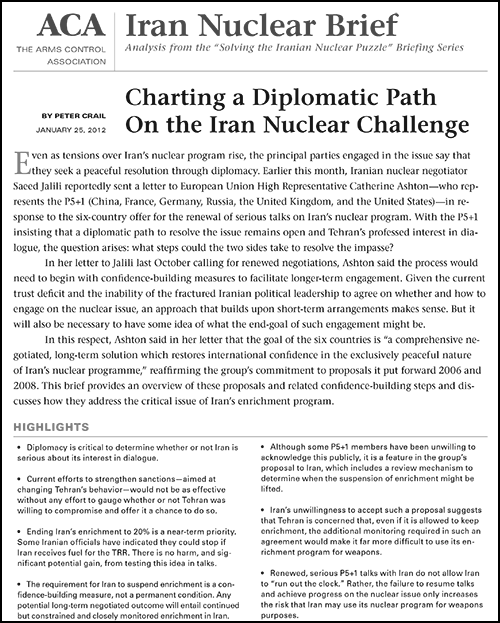January 25, 2012
By Peter Grail
 |
| Download PDF |
Even as tensions over Iran’s nuclear program rise, the principal parties engaged in the issue say that they seek a peaceful resolution through diplomacy.
Earlier this month, Iranian nuclear negotiator Saeed Jalili reportedly sent a letter to European Union High Representative Catherine Ashton—who represents the P5+1 (China, France, Germany, Russia, the United Kingdom, and the United States)—in response to the six-country offer for the renewal of serious talks on Iran’s nuclear program. With the P5+1 insisting that a diplomatic path to resolve the issue remains open and Tehran’s professed interest in dialogue, the question arises: what steps could the two sides take to resolve the impasse?
In her letter to Jalili last October calling for renewed negotiations, Ashton said the process would need to begin with confidence-building measures to facilitate longer-term engagement. Given the current trust deficit and the inability of the fractured Iranian political leadership to agree on whether and how to engage on the nuclear issue, an approach that builds upon short-term arrangements makes sense. But it will also be necessary to have some idea of what the end-goal of such engagement might be.
In this respect, Ashton said in her letter that the goal of the six countries is “a comprehensive negotiated, long-term solution which restores international confidence in the exclusively peaceful nature of Iran’s nuclear programme,” reaffirming the group’s commitment to proposals it put forward 2006 and 2008. This brief provides an overview of these proposals and related confidence-building steps and discusses how they address the critical issue of Iran’s enrichment program.
Presentations from earlier briefings in the ACA "Solving the Iranian Nuclear Puzzle" series are available from the ACA here.
